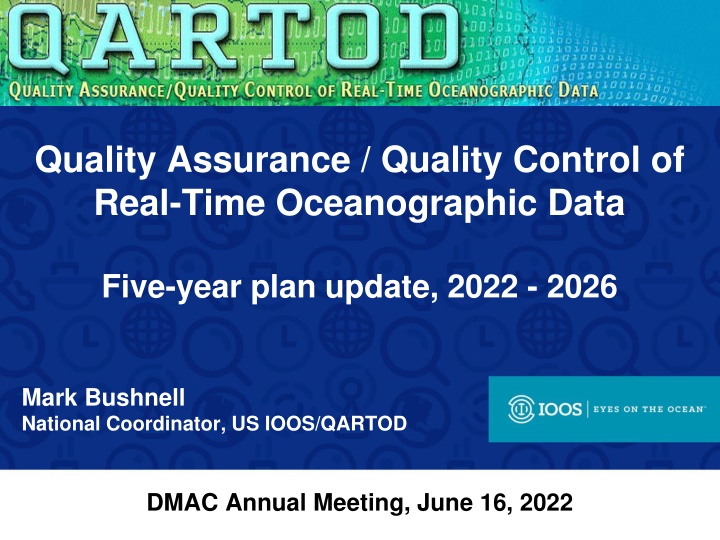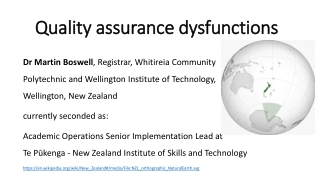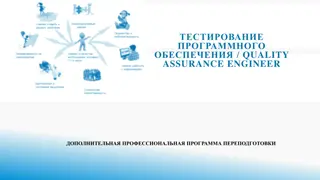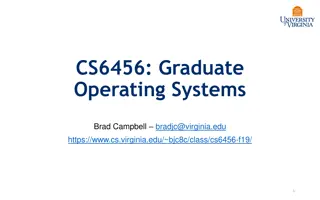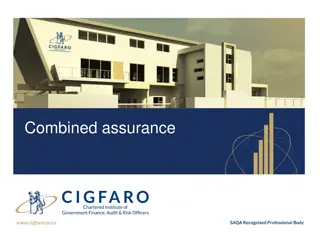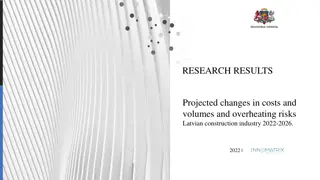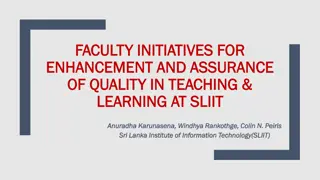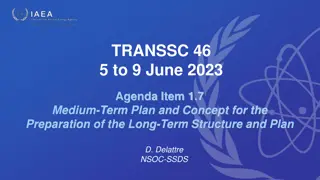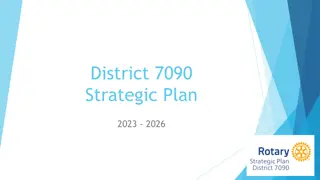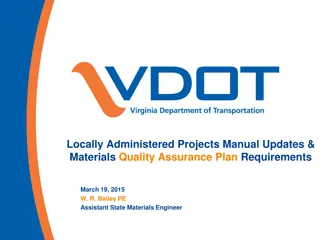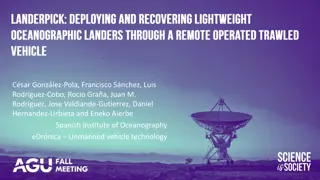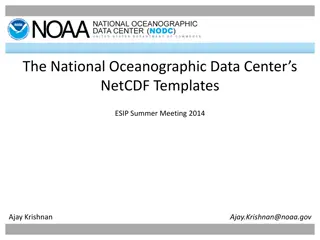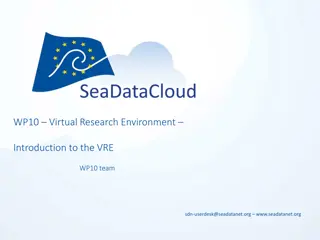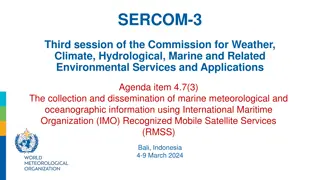Quality Assurance/Quality Control of Real-Time Oceanographic Data: Five-Year Plan Update 2022-2026
Update on the Quality Assurance/Quality Control plan for real-time oceanographic data, presented by Mark Bushnell at the US IOOS/QARTOD DMAC Annual Meeting in June 2022. The presentation covers the focus on real-time quality control manuals, the Seven Laws of QARTOD established in 2003, and the involvement of the Board of Advisors in developing the plan. The importance of quality descriptors, automated quality tests, metadata, sensor calibration, and manual checks is emphasized for maintaining data integrity. The evolution and future direction of the QARTOD project are also discussed, including community engagement and resource allocation.
Download Presentation

Please find below an Image/Link to download the presentation.
The content on the website is provided AS IS for your information and personal use only. It may not be sold, licensed, or shared on other websites without obtaining consent from the author.If you encounter any issues during the download, it is possible that the publisher has removed the file from their server.
You are allowed to download the files provided on this website for personal or commercial use, subject to the condition that they are used lawfully. All files are the property of their respective owners.
The content on the website is provided AS IS for your information and personal use only. It may not be sold, licensed, or shared on other websites without obtaining consent from the author.
E N D
Presentation Transcript
Quality Assurance / Quality Control of Real-Time Oceanographic Data Five-year plan update, 2022 - 2026 Mark Bushnell National Coordinator, US IOOS/QARTOD DMAC Annual Meeting, June 16, 2022
QARTOD, So Far Focus on real-time QC manuals, useful to those creating automated QC software Requires: Inter-operable data stream Data used in real-time Engaged user community No obvious additional core variables ready for a traditional QARTOD manual. What to do? 3
Seven Laws of QARTOD, 2003 1. Every real-time observation distributed to the ocean community must be accompanied by a quality descriptor. 2. All observations should be subject to some level of automated real-time quality test. 3. Quality flags and quality test descriptions must be sufficiently described in the accompanying metadata. 4. Observers should independently verify or calibrate a sensor before deployment. 5. Observers should describe their method / calibration in the real-time metadata. 6. Observers should quantify the level of calibration accuracy and the associated expected error bounds. 7. Manual checks on the automated procedures, the real-time data collected, and the status of the observing system must be provided by the observer on a time-scale appropriate to ensure the integrity of the observing system. 4
Board of Advisors Eugene Burger Kathy Bailey Regina Easley Julie Bosch Matt Biddle Karen Grissom Mario Tamburri Bob Jensen Jim Behrens Bob Heitsenrether Jennifer Dorton Christoph Waldmann Mark Bushnell 5
BOA Questionnaire 1 Developed with BOA input Sixteen multiple choice questions Most questions included provision for comments Results discussed during a BOA quarterly meeting Detailed summary of questionnaire appended to the Five-Year Plan update 6
BOA Questionnaire 2 1) QARTOD has evolved from its grassroots origin, to a U.S. IOOS project with a focus on QC manuals, and more recently shifting to include best practices, uncertainty, and development of additional QC manuals by the appropriate communities. Thinking about the resources and level of effort presently in place, which direction should the scope of the QARTOD project take? (select one): Expand the scope to address additional activities with additional resources. Scope is properly sized and should maintain focus on the 34 IOOS core variables as described in our recent paper (QARTOD - Prospects for Real-Time Quality Control Manuals, How to Create Them, and a Vision for Advanced Implementation, DOI: 10.25923/ysj8-5n28). QARTOD has completed its mission and should be scaled down or closed. 7
BOA Questionnaire 3 Several questions had a nearly unanimous response: A working group should be convened to assist with the development of the 5- year plan The present quarterly BOA meetings suffice Updating QC manuals was ranked as most important, but the frequency and method to determine which manual(s) to update was less clear Also ranking fairly high a) promote QARTOD to communities / variables not yet engaged, b) undertake documentation of best practices, and c) work towards embedding RT QC in field-deployed instruments While QARTOD s focus on real-time QC isn t as unique as it was when formed, it s still valuable Interaction with relevant international programs is very important Implementation of data flagging should still be left up to data providers The present community interaction and end-product dissemination efforts are fine 8
BOA Questionnaire 4 Some spread in responses to other topics BOA membership term limits were evenly split, about half for and half against Most thought QARTOD was right-sized, but one third of the BOA suggests expansion of scope & resources Most thought the present flexibility for the method(s) of dissemination of data quality metadata are adequate and desirable for data providers, but one-third of us called for QARTOD to be more prescriptive in setting standards Most preferred to leave establishment & record-keeping of test thresholds to data providers, but one-third thought QARTOD should be more engaged About evenly divided on the question of developing advanced testing, half for more effort and half for leaving it to others Most agreed that QARTOD should flex to accommodate the biological communities need for QC (e.g., timely data ) and best practice documentation. But there were concerns about diluting the QARTOD mission Most thought implementation and adherence to QARTOD QC tests should be left to the operators, but one-third thought we should be more proactive Only one-third ranked adding an early career ocean professional to the BOA highly 9
Five Year Plan Update - Process QARTOD Plan Update Development 1. BOA Questionnaire 2. Working group plan development 3. BOA input 4. Input from RAs and broader community 5. Findings to IOOS 6. Plan issued 10
Ongoing Core Activities Six core activities Foster implementation of existing manuals Update manuals Work with communities to develop new manuals as appropriate Interact with international entities as appropriate Promote outreach Work with manufacturers to embed QC tests in instruments 11
Expanded QARTOD Scope 1 QARTOD goes from QC of RT data to QA/QC of timely data Timely data - Include near-real time, but not post- processed QA that impacts timely data quality e.g., HF radar antenna pattern measurement 12
Expand QARTOD Scope 2 Uncertainty quantification Satellite and acoustic telemetry data for animal movement Seascape climatologies High frequency radar surface current observations antenna pattern measurements Vessel AIS data QC 13
Communities Generate Manuals Shifts the focus from an IOOS-led effort to a community-driven development of QARTOD manuals Designed to help communities whose variables of interest are not yet ready for a traditional QARTOD QC manual but are likely to benefit from the development of a QA/QC standardized process in the near future Plan update and other documents provide a framework for those communities moving forward 14
Discussion questions Will communities step up and produce their own manuals? Will another technical writer be available to support those communities? We ll miss Helen Worthington! Will IOOS be able to manage the expanded project scope without additional resources? Thank you DMAC members, for all you ve done to support and implement QARTOD QC!! 15
